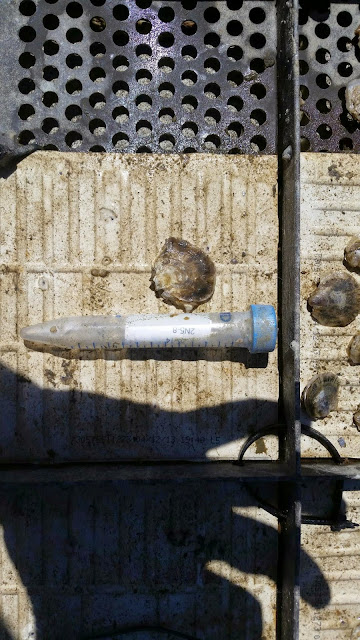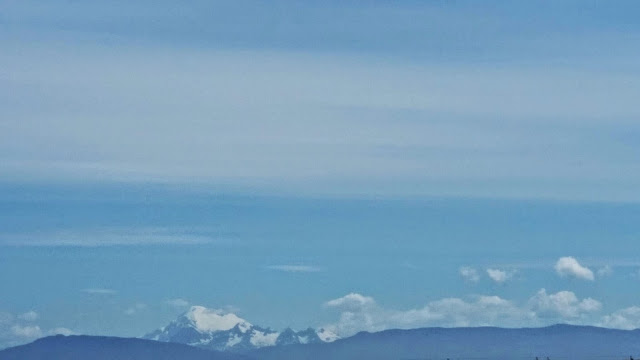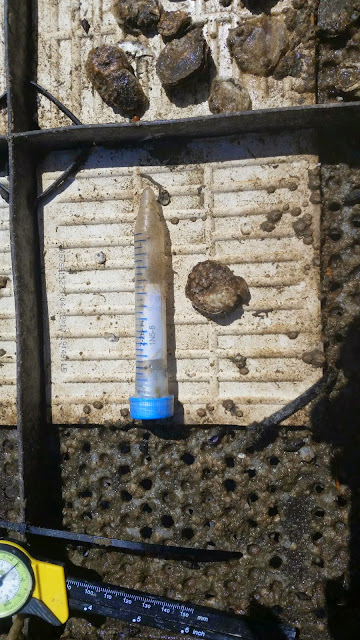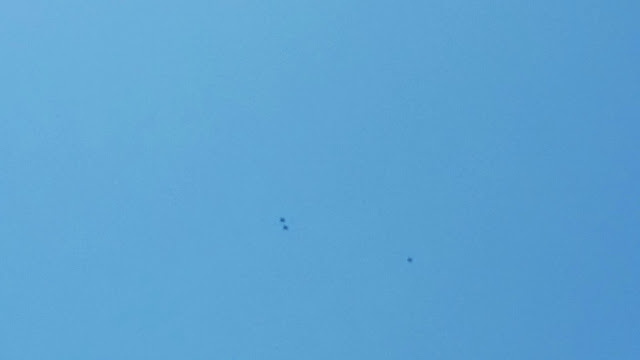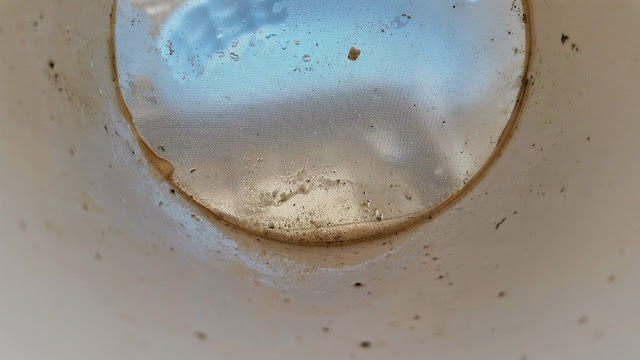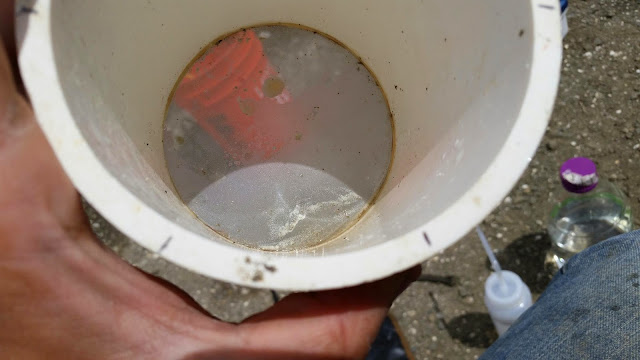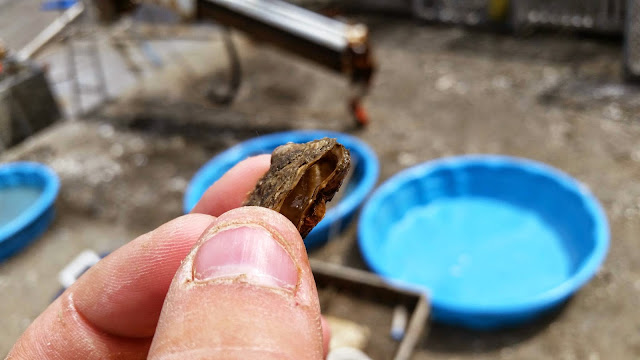Wednesday, June 11, 2014
6 11 2014 Manchester Repro
Temps Mid 60's to High 70s
Sunny
Participants: Joelle Blais and Jake Heare
Used the Anesthesia SOP to check for brooding larvae. I modified this per Steven and Brent's suggestions to temperature control via adding ice blocks to the solution as well as insulate the tub with 2 inch styrofoam insulation with foil top and bottom. Much to my surprise not only did the insulation work, kept water within 1 degree of ambient with out ice blocks, it actually lowered the temps of the treatment when ice blocks were added (2 degrees below ambient). I believe this insulation and ice blocks method will be the way to go from here on out. Even on the warmest days I see it insulating the tubs very well.
Numbers as follow:
Temps in C
Pretreatment
Initial 9
45 min 15
1.5 hrs 19
Treatment
Initial 11
45 min 11
1.5 hrs 10
2.25 hrs 8
Recovery
Initial 11
45 mins 13
1.5 hrs 15
Salinity in ppt
Pretreatment 25
Treatment 65
Recovery 25
Brood Collection
4H1-4
Brood 0
Gapin 63
Dead 2
Closed 31
4S9-12
Brood 0
Gaping 49
Dead 12
Closed 37
4N9-12
Brood 0
Gaping 41
Dead 8
Closed 12
One male in the 4H group had sperm within its shell. I assume these animals are attempting to spawn though water temps seem to be below expectation.
Friday, June 6, 2014
6 6 2014 fidalgo repro check
Followed the anesthesia sop at fidalgo. Attempted to keep the treatment Temps around 11 c where the ambient water was. The direct sun had other plans. Will need way way way more gel bags. even then it might be more than can actually fit in the tub with the samples.
Also to my and hopefully everyone else's surprise. I found a Brooding oyster! If you can guess which population it came from before you look below, you are one smart cookie.
Numbers as follow
Temps
Pretreatment
Initial. 10
45 min. 15
1.5 hrs. 19
Treatment
Initial. 11
45 min. 16
1.5 hrs. 17
2.25 hrs. 19
Recovery
Initial 10
45 min. 15
1.5 hrs. 19
Salinity
Pretreatment. 20
Treatment. 63
Recovery. 21
Brood collection
2S9-12
Brood. 0
Gaping. 53
Dead. 1
Closed. 43
2H13-16
Brood. 0
Gaping. 58
Dead. 0
Closed. 33
2N5-8
Brood. 1
Gaping. 59
Dead. 2
Closed. 36
Brooders
# size(mm). Sick
1. 31. W
Lots of nukaluka in the water. Some may have been collected with brooding larvae. May muddy up counting.
Picture of brooders follows.
Thursday, June 5, 2014
6 5 2014 oyster bay repro check
Pretreatment.
Initial. 13
45 min. 16
1.5 hrs. 16
Initial. 10
45 min 17
1.5 hrs. 16
2.25 hrs. 16
Initial 13
45 min. 17
1.5 hrs 17
Pretreatment. 26
Treatment. 63
Recovery. 26
1S13-16
Brood. 2
Gaping. 60
Dead. 12
# size. Sick
1. 23. W
2. 29. W
Brood. 2
Gaping 79
Dead. 7
# size. Sick
1. 25. W
2. 24. Grey
Brood. 1
Gaping. 52
Dead 7
# size. Sick
1. 30. W
Wednesday, June 4, 2014
6 4 2014 Manchester Repro Check
 |
| Brooding Olys in Hatchery |
 |
| Flow through with bong screen to catch Oly larvae. |
 |
| Various flowthroughs for brooding Olys |
 |
| Oly larvae (invisible) |
 |
| Larval Tanks and Ryan's Gesticulation |
 |
| Chipmunk |
 |
| Baby Goslings! |
 |
| Clam Bay with glassy surface waters! |
Friday, May 30, 2014
5 30 2014 fidalgo repro check
Pretreatment
Initial 10
45 min. 12
1.5 hrs 16
Initial. 9
45 min. 13
1.5 hrs. 16
2.25 hrs. 19
Initial. 9
45 min. 13
1.5 hrs. 16
Seawater. 30 ppt
Treatment. 65 ppt
2S5-8
Brood. 0
Gaping. 77
Dead. 1
Brood. 0
Gaping. 46
Dead. 0
Brood. 0
Gaping. 50
Dead. 1
Thursday, May 29, 2014
5 29 2014 oyster bay repro check
Mid 60s
President treatment bath
Initial. 15.5
45 min. 15.5
1.5 hrs. 16.5
Initial. 11
45 min. 12
1.5 hrs. 15
2.25 hrs. 16
Initial. 14
45 min 17
1.5 hrs. 18
2.25 hrs. 18
Pretreatment. 25
Treatment. 70
Recovery. 25
1H1-4
Brood. 1
Gaping 80
Dead. 7
Brooders info
# size (mm). Larvae taken
1. 24. y
Brood. 5
Gaping 74
Dead. 9
Brooders info
# size (mm) larvae taken
1. 36. Y
2. 26. Y
3. 26. Y
4. 25. Y
5. 28. Y
Brood. 2
Gaping 51
Dead. 6
Brooders info
# size (mm) larvae taken
1. 27. Y
2. 28. Y
Wednesday, May 28, 2014
5 28 2014 Manchester Repro Check
Mid 60s
Started partly cloudy and warm, then rained later in the day while finishing the last tray check.
Took temperatures while the temp probe still worked. Probe failed halfway through the day due to being doused with salt water.
Followed procedure listed in the Reproduction Anesthesia SOP. Modified the procedure at the end by eliminating the time for the final tray to recover due to the torrential rain.
Also took salinity of the water collected as well as the treatment salinity.
Temps as follows:
Seawater for pre treatment in C
Initial: 13.1
45 min: 19.5
1.5 hrs: 23.8
Treatment Temps in C
Initial: 15.3
45 mins: 21.2
1.5 hrs: 23.5
Salinity (taken during initial collection/treatment creation)
Seawater: 26.5 ppt
Treatment: 68.5 ppt
Brooding Conditions as follows:
4S1-4
Brood 0
Gaping 43
Dead 9
4H5-8
Brood 0
Gaping 27
Dead 0
4N5-8
Brood 0
Gaping 54
Dead 15
There were two oysters in 4H5-8 and three in 4N5-8 that looked like candidated for brooding due to darkened gill tissues. Rinsed all 5 thoroughly with seawater in to 52 um screen but collected nothing. Gill tissue color did not change. I assumed these animals were not brooding based on this.
